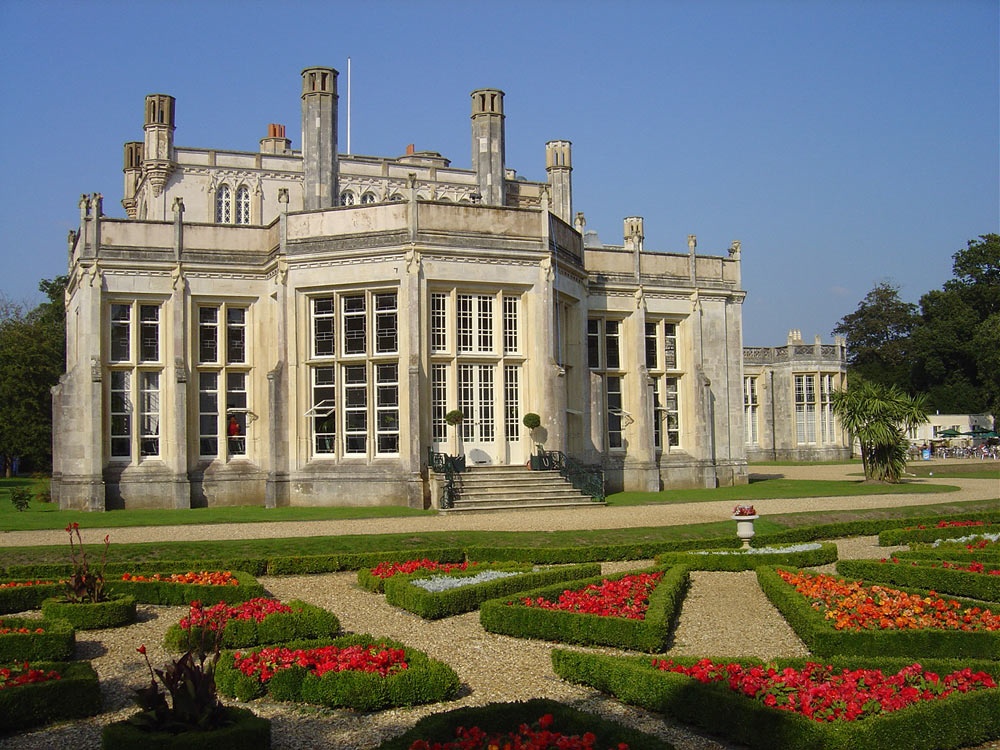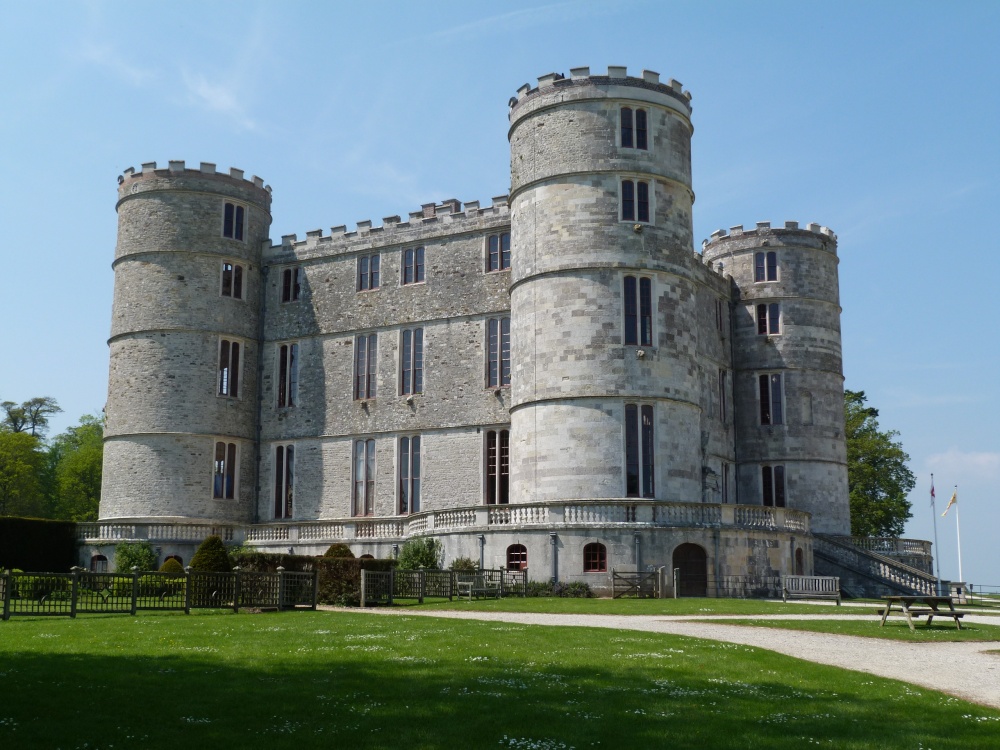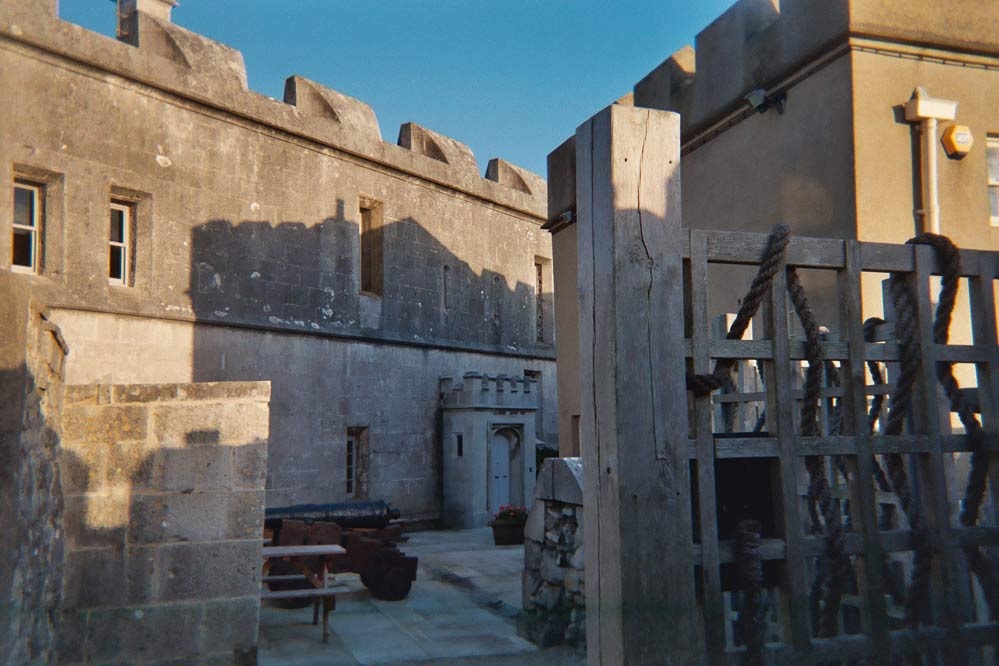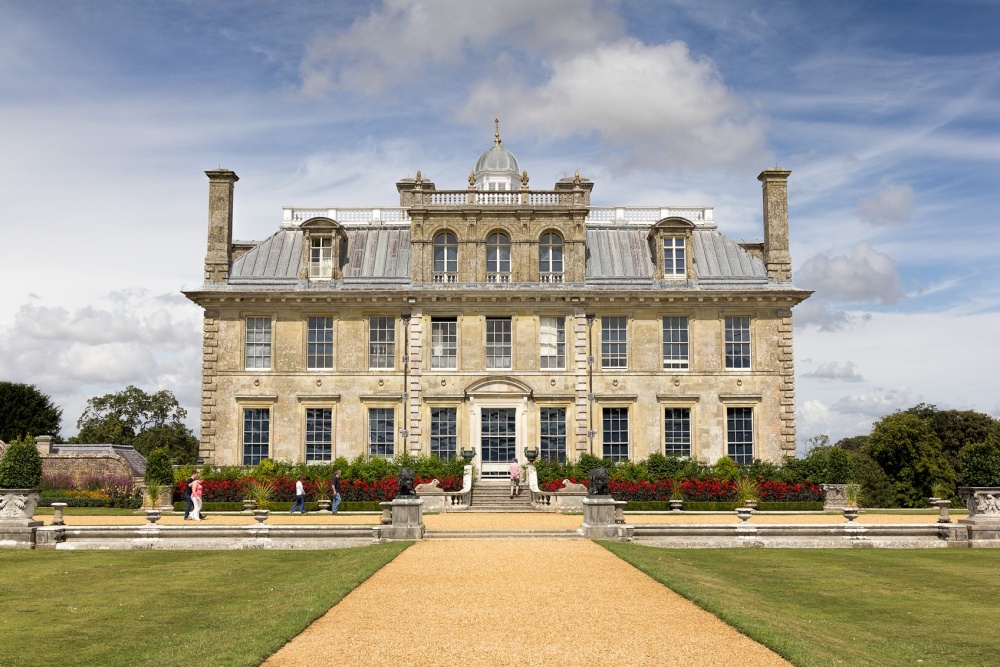
Highcliffe Castle - Image by PicturesOfEngland.com member lucsa (view gallery)

Thomas Hardy's cottage in Higher Bockhampton, Dorset - Image by PicturesOfEngland.com member Jan Vanhentenrijck (view gallery)
Home of poet and novelist Thomas Hardy until the age of 34.
Under the Greenwood Tree and Far from the Madding Crowd were written here.
ID#9871

Lulworth Castle - Image by PicturesOfEngland.com member JudiJ (view gallery)
ID#10015

Athelhampton House - Image by PicturesOfEngland.com member Phil Jobson (view gallery)
Athelhampton House is a fine example of a 15th Century house nestling in deepest Dorset.
ID#16

Portland Castle, Dorset - Image by PicturesOfEngland.com member Baileydad50@aol.com (view gallery)
This is one of the best preserved of all King Henry VIII's mighty fortresses, built by the monarch to guard the south coast against invasion from the French and the Spanish.
The castle was built around 1540, of white Portland stone, it stands in a superb position overlooking Portland and Weymouth Harbour. It was further extended in the 17th-century, and again in the 18th-century when it was the home of Captain Charles Manning, builder of the Portland breakwater.
Portland castle has had a somewhat strange history, it was never used as intended and only saw action during the English Civil War when it frequently changed hands between the Royalists and the Parliamentarians.
In the year 1870 the Government of the day took over the castle, and it was later used during World War I as a Seaplane base, and again in World War II, when it was used for part of the D Day Operations.
Visitors to Portland will find the castle sitting serenely within the Royal Naval Dockyard.
ID#10092

Sherborne Abbey - Image by PicturesOfEngland.com member Paul V. A. Johnson (view gallery)
Without doubt this magnificent Abbey built centuries ago of creamy Ham stone ranks amongst the finest Abbey churches anywhere in England. In a market town blessed with so many beautiful old buildings, the Abbey dating mainly from the 15th century is a showpiece supreme.
The Abbey possesses many historic treasures from its noble past. Amongst these, are several fine monuments including effigies of 13th century abbots. Of the memorials, the most noted is the 17th century memorial to the Earl of Bristol by John Nost. There are fine misericords of the 15th century, magnificent fan vaulting, Purbeck marble columns, superb statues, and there are Saxon doorways and some fine Norman arcading. Just as the majestic exterior glows in the warmth of the sun, its dazzling rays stream through magnificent windows, illuminating intricate woodcarving and showing to best advantage the art of the medieval monks, and craftsmen who worked tirelessly to make this hallowed place the fine Abbey church we see today.
Sherborne was the seat of Saxon Bishops, and there was almost certainly a Saxon church here for several hundred years. In the 10th century a Benedictine monastery was established, but it was not until early in the 12th century that full abbey status was granted. The religious community lived and worked peacefully here for a further 300 years, until the time of the Dissolution in 1539 when it was taken over by the Crown. At a later date the people of the town banded together to purchase the magnificent building back.
If the abbey is impressive, then it is also evocative. As the evening shadows lengthen and the great bell tolls, it has an overwhelming haunting effect when you can almost see and feel the presence of the tiny community who founded this beautiful historic church so many centuries ago. Sherborne Abbey is indeed an experience not to be missed.
ID#9525

Highcliffe Castle - Image by PicturesOfEngland.com member lucsa (view gallery)
This stunning Grade 1 listed Mansion is situated on the cliffs at Highcliffe, overlooking Christchurch Bay and The Isle of Wight. It was built between 1831 and 1835 by Lord Stuart de Rothesay, and is often described as the most important surviving house of the Romantic and Picturesque style of architecture.
The building was derelict for 2 decades after 2 fires, but has now been fully restored externally.
The castle is free to visit and is often used as a wedding venue. The grounds were designed by the famous Capability Brown.
ID#10509

Sherborne Castle - Image by PicturesOfEngland.com member MikeT (view gallery)
Many fascinating tales remain from the time when Sherborne Castle was lived in by Sir Walter Raleigh, a favourite of Elizabeth I. Raleigh, a seasoned charmer, had coveted the Sherborne estate for some time, he admired the superb location of what was then a hunting lodge, and somehow he managed to persuaded the Queen to request the tenure of the castle from the Bishop of Salisbury. Once Elizabeth acquired the lease, she immediately passed it over to Raleigh, and when two years later he was banished from Court, he built himself a new house which he called "The Lodge", a name which stuck until around 1800. The house was a handsome square structure, with mellow walls standing four storey's high. It was adorned with graceful towers, pinnacles, heraldic beasts and magnificent chimney stacks, all of which stood out against the warm Dorset skyline. Unfortunately, Raleigh's tenancy was short-lived, he was executed in 1616, and after this Sherborne Castle estate was granted to Sir John Digby, who later became Earl of Bristol. Today, this family still live at Sherborne castle.
The Digby family enhanced the castle by the addition of four long wings, and yet more towers. In later years "Capability Brown" set out the magnificent landscape, making it a fitting backdrop for what is arguably one of the most romantic looking of all English castle's. The interior, although lavish, has smaller rooms than one would normally expect to find. That said, the scale of the state rooms is impressive, so too is the Solarium and Library. There are other more intimate rooms, each is special and all have stunning views over the garden, with its lovely flower beds, shaded bowers and picturesque lake with its abundance of wildlife.
In this wonderfully serene place visitors can enjoy a variety of experiences. Although the house was extensively redecorated in the 19th century, some of the rooms escaped, and these have remained largely untouched since the 17th century. Thus, the visitor is able to see unique interiors from most decorative periods of English architecture and interior design.
During its history the castle has opened its doors to the great and the good of several centuries. Past "Royal" visitors have included Prince William of Orange who visited in the 17th century, and George III who stayed at the castle in 1789.
Collections include fine Georgian furniture, porcelain, many splendid family portraits and other interesting paintings and works of art.
In the grounds you can explore the Adam-style Orangery, enjoy afternoon tea in the Tea Garden and hunt for souvenirs in the well stocked gift shop. In the distance, across the park you can catch a glimpse of all that remains of the old 12th century Norman castle.
Sherborne Castle is open from March until October.
ID#9513

Kingston Lacy - Image by PicturesOfEngland.com member Andreas Lindberg (view gallery)
Set in 250 acres of spectacular parkland landscaped in the latter half of the 18th century and now roamed by a herd of Red Devon Cattle, Kingston Lacy is one of the earliest surviving houses built in a Classical style after the Restoration of 1660.
The manor of Kingston Lacy took its name from its medieval owners, the de Lacey's who were Earls of Lincoln. Prior to this, for long periods it had been held by the Royal family until Sir John Banks bought it in 1637. The present Restoration mansion was built to replace Corfe Castle, the original family seat which despite the valiant efforts of Lady Mary Banks, who held out against Parliamentarian troops, was seized and ruined during the Civil War.
Kingston Lacy House was designed by Sir Roger Pratt, a disciple of Inigo Jones. Building commenced in 1663 and the house of just two storey's with a semi-basement was completed in 1665. The chosen building material was an attractive red-brick with stone dressings, today is beautifully mellowed. Sir Charles Barry was instructed in 1835 to restore the cupola and other features. This restoration work was not completed until 1839, by which time the house had been subject to extensive "improvements" by Barry who added the decorative chimney's to the skyline and lowered the ground level to convert the basement into a full floor on the main front.
Sir Charles Barry was also responsible for the spectacular Renaissance interior, a flamboyant style much favoured by him at the time and which includes the splendid marble staircase. The Spanish Room is the "piece de resistance" of the house, this shows magnificent works of art collected in Spain during the Peninsular War by William John Banks, these are displayed against gilded leather hangings beneath a superb coffered ceiling. Included in the paintings is Velazquez's portrait of Cardinal Massami. Dominating the Dining Room is Sebastiano del Piombo's, unfinished masterpiece "The Judgement of Solomon". Other priceless treasures in the house include a fine collection of Egyptian artefacts from 3000BC and amongst Kingston Lacy's famous collection of paintings are works by Titian and Van Dyck.
Beyond the house, in the lovely grounds and gardens visitors can see the four pink obelisks brought back from a temple on the River Nile by William John Bankes. There is a pleasant cedar walk planted with trees by earlier notable visitors, including the Duke of Wellington and a lovely Lime Avenue leads to the Nursery Wood arboretum.
Kingston Lacy is in the care of the National Trust, who at present are restoring the pretty Edwardian garden.
ID#9750

Wimborne Minster - Image by PicturesOfEngland.com member Ruth Gregory (view gallery)
ID#9775

Abbey Ruins - Image by PicturesOfEngland.com member Jennie Peters (view gallery)
Abbotsbury Abbey was founded in the 11th century by a Dane called Orca who was a follower of Cnut. The Abbey dominated the town for over 500 years but was destroyed in the 1500's during the dissolution of the monastries. Only part of the Abbey was left due to its usefulness, this is called Tithe Barn and is one of the oldest in Britain.
ID#141
| Article Title | Author | Date |
| The Prettiest Streets in England | poe | 24th November 2020 |
| 10 of the best villages to visit in the Peak District, England | poe | 28th July 2020 |
| A look at some of the most famous views in England... | poe | 16th May 2020 |
| THE TRIAL OF THE PYX | Paul V. A. Johnson | 19th August 2019 |
| Tyneham - Dorset's Lost Village | poe | 9th June 2016 |
| The Best Sandy Beaches in Dorset | poe | 7th June 2016 |
| 20 Of The Best Market Towns In England | poe | 1st June 2016 |
| A Human Heart and a Ghost Story in a Northamptonshire Church | Charles Moorhen | 30th October 2009 |
| Exploring the English Village Churchyard | Charles Moorhen | 29th October 2009 |
| Local Legends - The Basingstoke Burial | poe | 28th February 2008 |